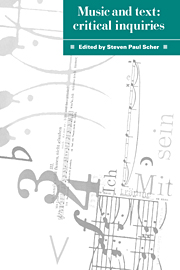Book contents
- Frontmatter
- Contents
- List of figures
- List of contributors
- Preface
- Acknowledgments
- Part I Institutional dimensions and the contexts of listening
- Part II Literary models for musical understanding: music, lyric, narrative, and metaphor
- 4 Lyrical modes
- 5 Origins of modernism: musical structures and narrative forms
- 6 Metaphorical modes in nineteenth-century music criticism: image, narrative, and idea
- 7 Narrative archetypes and Mahler's Ninth Symphony
- Part III Representation, analysis, and semiotics
- Part IV Gender and convention
- Index
5 - Origins of modernism: musical structures and narrative forms
Published online by Cambridge University Press: 04 September 2009
- Frontmatter
- Contents
- List of figures
- List of contributors
- Preface
- Acknowledgments
- Part I Institutional dimensions and the contexts of listening
- Part II Literary models for musical understanding: music, lyric, narrative, and metaphor
- 4 Lyrical modes
- 5 Origins of modernism: musical structures and narrative forms
- 6 Metaphorical modes in nineteenth-century music criticism: image, narrative, and idea
- 7 Narrative archetypes and Mahler's Ninth Symphony
- Part III Representation, analysis, and semiotics
- Part IV Gender and convention
- Index
Summary
Comparison of literature and the visual arts is much more common than comparison of literature and music. For, as Roland Barthes wrote in a late essay that in part exemplifies the problem, “It is … very difficult to speak about music. Many writers have spoken well about painting; none, I believe, has spoken well about music, not even Proust. The reason is that it is very difficult to link language, which is of the order of the general, and music, which is of the order of difference.” Music, as Barthes says in another essay, is “inactual,” or, as I should put it, abstract. Non-specialists often feel that they can look at a painting and discern what it represents; and even those who know nothing about painting techniques are liable to have imbibed a few useful elementary notions of pictorial form. Far fewer stare at a musical score with anything but discomfort. Music suffers doubly: first from being nonrepresentational, and second from being written in a script that is arduous to learn. Even the most avid listeners would no sooner write about a piece of music than about a poem in a language they cannot read.
Yet despite Barthes's engagement on behalf of a purely affective approach, the analysis of music holds great potential. For what music lacks in external referentiality, it gains in the distinctness of internal relationships. If it is the most abstract art, it is also the most highly formalized.
- Type
- Chapter
- Information
- Music and TextCritical Inquiries, pp. 75 - 92Publisher: Cambridge University PressPrint publication year: 1992
- 1
- Cited by



